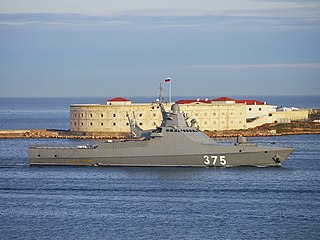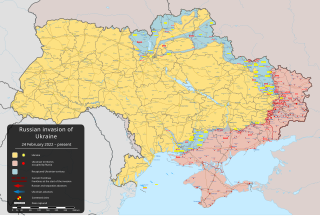
The Black Sea Fleet is the fleet of the Russian Navy in the Black Sea, the Sea of Azov and the Mediterranean Sea. The Black Sea Fleet, along with other Russian ground and air forces on the Crimean Peninsula, are subordinate to the Southern Military District of the Russian Armed Forces. The fleet traces its history to its founding by Prince Potemkin on 13 May 1783 as part of the Imperial Russian Navy. The Russian SFSR inherited the fleet in 1918; with the founding of the Soviet Union in 1922, it became part of the Soviet Navy. Following the collapse of the Soviet Union in 1991, the Black Sea Fleet was partitioned between the Russian Federation and Ukraine in 1997, with Russia receiving title to 82% of the vessels.

An unmanned surface vehicle, unmanned surface vessel or uncrewed surface vessel (USV), colloquially called a drone boat, drone ship or sea drone, is a boat or ship that operates on the surface of the water without a crew. USVs operate with various levels of autonomy, from remote control to fully autonomous surface vehicles (ASV).

The Ropucha class, Soviet designation Project 775, is a class of landing ship built in Poland for the Soviet Navy. The ships were built in the Stocznia Północna shipyards in Gdańsk, Poland. They were designed for beach landings, and can carry 450 tons of cargo. The ships have both bow and stern doors for loading and unloading vehicles, and the 630 square metres (6,800 sq ft) of vehicle deck stretch the length of the hull. Up to 25 armored personnel carriers can be embarked.

Tsezar Kunikov (BDK-64), sometimes anglicised as Caesar Kunikov, is a Project 775, large landing ship of the Russian Navy. The ship was built in Poland, launched in 1986 and named after Soviet Naval Infantry officer Tsezar Kunikov. As part of the Russian Black Sea Fleet, it took part in the KFOR mission, the Russo-Georgian War, the Syrian Civil War, and the Russo-Ukrainian War.

Lake Donuzlav, also referred to as Donuzlav Bay, is the deepest lake of Crimea and biggest in Chornomorske Raion. It is a protected landscape and recreational park of the Autonomous Republic of Crimea.

Project 22160 is a series of large patrol ships being constructed for the Russian Navy. The vessels are primarily intended for duties such as patrol, monitoring and protection in open and closed seas. The first ship was laid down in February 2014 and joined the Russian Navy in December 2018. By January 2018, six ships were under construction. Between 2017 and 2022, four ships had been launched.

R-360 Neptune is a Ukrainian subsonic cruise missile with all-weather capabilities developed by the Luch Design Bureau in Kyiv. Originally designed as an anti-ship missile, an alternative model was fielded in 2023 with a new guidance system to support land-attack roles. With a range of over 200 kilometres, it is intended to neutralize naval targets up to 9,000 tonnes.

Vasily Bykov is a project 22160 patrol ship of the Russian Navy, of which it was the first ship built. It was laid down on 26 February 2014 on the Zelenodolsk Shipyard at Zelenodolsk in Tatarstan, Russia, and launched on 28 August 2017. Vasily Bykov was commissioned on 20 December 2018 in the Novorossiysk Naval Base at Novorossiysk, becoming part of the Black Sea Fleet.

The Berdiansk port attack was a strike carried out by Ukrainian forces against Russian Navy ships moored in the Port of Berdiansk on 24 March 2022, during the Russian invasion of Ukraine. The Alligator-class landing ship Saratov was sunk, and one of the two Ropucha-class landing ships took damage but was able to leave the port.

The Russian warship Moskva, the flagship of the Russian Navy's Black Sea Fleet, sank on 14 April 2022 during the Russian invasion of Ukraine. Ukrainian officials announced that their forces had hit and damaged it with two R-360 Neptune anti-ship missiles, and that the ship had then caught fire. The United States Department of Defense later confirmed this, and Russia reported that the ship had sunk in stormy seas after the fire reached munitions onboard and they exploded.

Novocherkassk (BDK-46) was a Ropucha-class landing ship of the Russian Navy and part of the Black Sea Fleet. Named after Russian city of Novocherkassk, the ship was built in Poland and launched in 1987.

Beginning in July 2022, a series of explosions and fires occurred on the Russian-occupied Crimean Peninsula from where the Russian Army had launched its offensive on Southern Ukraine during the Russian invasion of Ukraine. Occupied since 2014, Crimea was a base for the subsequent Russian occupation of Kherson Oblast and Russian occupation of Zaporizhzhia Oblast. The Ukrainian government has not accepted responsibility for all of the attacks.

Aerial warfare in the Russian invasion of Ukraine began at dawn of 24 February 2022, with infantry divisions and armored and air support in Eastern Ukraine, and dozens of missile attacks across Ukraine. The first fighting took place in Luhansk Oblast near the village of Milove on the border with Russia at 3:40 am Kyiv time. The main infantry and tank attacks were launched in four spearhead incursions, creating a northern front launched towards Kyiv, a southern front originating in Crimea, a south-eastern front launched at the cities of Luhansk and Donbas, and an eastern front. Dozens of missile strikes across Ukraine also reached as far west as Lviv. Drones have also been a critical part of the invasion, particularly in regards to combined arms warfare. Drones have additionally been employed by Russia in striking Ukrainian critical infrastructure, and have been used by Ukraine to strike military infrastructure in Russian territory.

Sergey Kotov was a Project 22160 patrol ship of the Russian Navy. She was attacked in the Black Sea by Ukrainian forces using MAGURA V5 maritime drones on 5 March 2024, and Ukrainian intelligence claimed the ship was sunk.

Naval warfare in the Russian invasion of Ukraine began on 24 February 2022, when the Russian Armed Forces launched a full-scale invasion of Ukraine, in a major escalation of the Russo-Ukrainian War, which began in 2014. Media reporting of and focus on the invasion has largely been on the terrestrial and aerial aspects – however, maritime engagements have been consequential during the conflict. Disputes over Ukrainian grain exports through the Black Sea have also played a significant role.
Marichka is a Ukrainian-made multi-purpose autonomous underwater vehicle (AUV) capable of performing underwater attack missions, as well as cargo transportation and reconnaissance.

Sea Baby is a Ukrainian multi-purpose unmanned surface vehicle (USV) developed for use by the Security Service of Ukraine (SBU) during the Russian invasion of Ukraine. It is able to carry an explosive payload for use in kamikaze attacks, or equipped with other equipment loadouts for more specialised use.
















